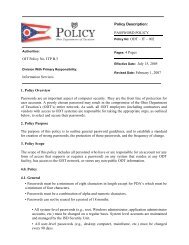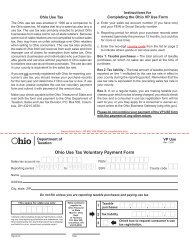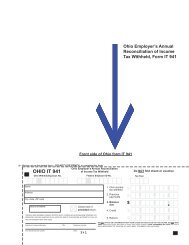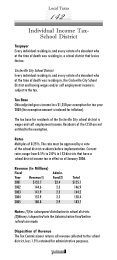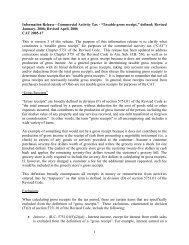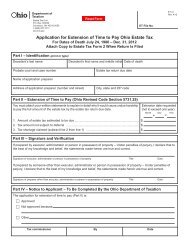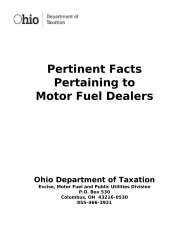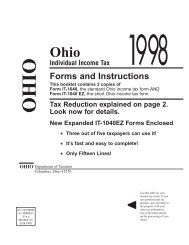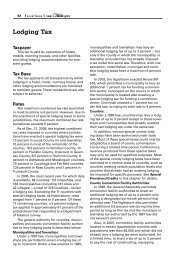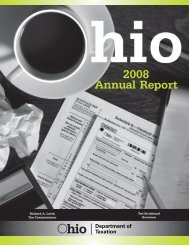Local Government Fund Presentation - Ohio Department of Taxation
Local Government Fund Presentation - Ohio Department of Taxation
Local Government Fund Presentation - Ohio Department of Taxation
Create successful ePaper yourself
Turn your PDF publications into a flip-book with our unique Google optimized e-Paper software.
- A History <strong>of</strong> the <strong>Local</strong> <strong>Government</strong> <strong>Fund</strong><br />
and the <strong>Local</strong> <strong>Government</strong> Revenue<br />
Assistance <strong>Fund</strong> -<br />
By Christopher Hall, <strong>Ohio</strong> <strong>Department</strong> <strong>of</strong> <strong>Taxation</strong><br />
Presented to the <strong>Local</strong> <strong>Government</strong> and Library Revenue<br />
Distribution Task Force<br />
January 31, 2006
<strong>Presentation</strong> Organization<br />
• Introductory discussion <strong>of</strong> general purpose “revenue<br />
sharing” and basic description <strong>of</strong> the LGF and LGRAF<br />
• Origins <strong>of</strong> the LGF and changes made through the 1980’s<br />
• Discussion <strong>of</strong> the LGRAF<br />
• LGF and LGRAF developments since the early 1990’s<br />
• Final comments and observations
Structure <strong>of</strong> the LGF, Part One:<br />
Monthly distributions to 88 county undivided<br />
local government funds<br />
Adams County Undivided LGF<br />
(may also receive dealer in intangibles revenue)<br />
Distributions to subdivisions:<br />
County Govt.<br />
Townships<br />
Municipalities<br />
State <strong>Local</strong> <strong>Government</strong> <strong>Fund</strong><br />
(<strong>Fund</strong>ed by major state taxes)<br />
Approx. 91% <strong>of</strong> State LGF goes to 88 county undivided LGFs<br />
86 other undivided LGFs<br />
(may also receive dealer in intangibles revenue)<br />
Distributions to subdivisons:<br />
County Govt.<br />
Townships<br />
Municipalities<br />
Park Districts (34 counties)<br />
Wyandot County Undivided LGF<br />
(may also receive dealer in intangibles revenue)<br />
Distributions to subdivisions<br />
County Govt.<br />
Townships<br />
Municipalities
Structure <strong>of</strong> the LGF, Part Two:<br />
Monthly distributions to municipalities with<br />
an income tax<br />
State <strong>Local</strong> <strong>Government</strong> <strong>Fund</strong><br />
(<strong>Fund</strong>ed by major state taxes)<br />
Approx. 9% <strong>of</strong> State LGF goes to 541 municipalities with an income tax<br />
Village <strong>of</strong> Manchester (Adams Co.) 539 other municipalities Village <strong>of</strong> Sycamore (Wyandot Co.)
Summary <strong>of</strong> LGF/LGRAF Estimation &<br />
Distribution Process<br />
• By July 15, Tax Commissioner certifies to each county auditor the<br />
estimated amount to be distributed to the county undivided LGF and<br />
the county undivided LGRAF during the following calendar year<br />
• In August, the county budget commission computes each subdivision’s<br />
share <strong>of</strong> the county undivided LGF and LGRAF for the next calendar<br />
year; within 10 days, county auditor reports those amounts to the<br />
subdivisions<br />
• Each month the Tax Commissioner distributes the prior month’s LGF<br />
(and dealer in intangibles taxes) deposits and LGRAF deposits to each<br />
county undivided LGF and LGRAF, respectively, using each county’s<br />
percentage share computed in the preceding July; a portion <strong>of</strong> the LGF<br />
is also distributed monthly to municipalities with an income tax;<br />
distributions are made by the 10 th <strong>of</strong> each month<br />
• County treasurer distributes the amount received in the undivided LGF<br />
and undivided LGRAF to the various subdivisions based on<br />
subdivision percentage shares authorized by the county budget<br />
commission
General Purpose Revenue Sharing<br />
• The LGF and LGRAF, along with the Library and <strong>Local</strong><br />
<strong>Government</strong> Support <strong>Fund</strong> (LLGSF), comprise the state’s<br />
“general purpose revenue sharing” programs for local<br />
governments<br />
• <strong>Ohio</strong> has other revenue sharing programs – e.g., sharing <strong>of</strong><br />
motor fuel tax and <strong>of</strong> estate tax revenues – but they do not<br />
constitute “general purpose” revenue sharing<br />
• The LGF, LGRAF and LLGSF have two key<br />
characteristics not simultaneously present with other<br />
revenue sharing programs:<br />
– The money is not for specific purposes (for the general fund)<br />
– The money goes to local governments based on criteria other than<br />
the origin <strong>of</strong> the tax revenues
General Purpose Revenue Sharing (con’d)<br />
• The federal government had a general revenue sharing<br />
program which originated during the Nixon Administration<br />
• A portion <strong>of</strong> federal revenues was shared with states and<br />
local governments<br />
• Revenue sharing was a product <strong>of</strong> that administration’s<br />
“New Federalism”, providing revenues to states and local<br />
governments with few programmatic requirements (in<br />
contrast to the many categorical grant programs developed<br />
during the 1960’s)<br />
• Federal revenue sharing with local governments existed<br />
from 1972 to 1986 (although revenue sharing with states<br />
ended after 1981), terminated as a result <strong>of</strong> deficit<br />
reduction.
Origins <strong>of</strong> General Revenue Sharing in <strong>Ohio</strong><br />
• <strong>Ohio</strong>’s general purpose revenue sharing program<br />
originated well before the federal program<br />
• The <strong>Local</strong> <strong>Government</strong> <strong>Fund</strong> was created when the state<br />
sales tax was enacted in December 1934<br />
• Revenue from the new 3% state sales tax was to be used<br />
for a county poor relief excise fund and for a state public<br />
school fund, with any remaining revenue to be used for the<br />
new “<strong>Local</strong> <strong>Government</strong> <strong>Fund</strong>”<br />
• In the first year <strong>of</strong> the LGF (1935), $10.7 million was sent<br />
to local governments, out <strong>of</strong> $45.1 million in total state<br />
sales tax revenue
Origins <strong>of</strong> General Revenue Sharing in <strong>Ohio</strong><br />
(con’d)<br />
• Basic structure <strong>of</strong> the original LGF has been maintained to<br />
this day: state revenue earmarked for LGF (replaced by an<br />
appropriation beginning in 1939); LGF monies distributed<br />
to 88 undivided LGFs; and funds subsequently distributed<br />
by county budget commission to eligible subdivisions<br />
• Between 1935 and 1938 the portion <strong>of</strong> the state sales tax<br />
directed to the LGF varied, with the percentage during that<br />
period varying between 24% and 32%<br />
• Beginning in 1939, the earmarking concept was replaced<br />
by annual appropriations (i.e., a flat $12 million annual<br />
appropriation through 1944, with increases during the<br />
1945-1947 period)
Origins <strong>of</strong> General Revenue Sharing in <strong>Ohio</strong><br />
(con’d)<br />
• Originally, the State LGF was distributed to 88 county<br />
undivided LGFs based on each county’s proportionate<br />
share <strong>of</strong> municipal valuation (real, tangible personal and<br />
utility property); the average valuation over the preceding<br />
five years was used<br />
• Distribution effect: The higher a county’s municipal<br />
valuation, the higher its LGF distribution<br />
• Starting in 1945 (when the LGF was increased from $12 to<br />
$16 million), 75% <strong>of</strong> the LGF was distributed based on<br />
each county’s share <strong>of</strong> municipal valuation and 25% was<br />
distributed based on each county’s share <strong>of</strong> population<br />
• The valuation-population distribution criteria, as well as<br />
the relative 75% -25% weights, exist to this day
Origins <strong>of</strong> General Revenue Sharing in <strong>Ohio</strong><br />
(con’d)<br />
• Subdivisions receiving county undivided LGF monies:<br />
counties, municipal corporations, park districts, and<br />
townships<br />
• From the beginning, state law has required monies from<br />
each county undivided LGF to be apportioned to the<br />
county’s subdivisions based on the relative “need” <strong>of</strong> each<br />
subdivision<br />
• According to the original statute, the county budget<br />
commission convenes to consider facts and information<br />
presented by the county auditor and then determine the<br />
amount needed by the subdivision for its current operating<br />
expenses (to the extent those expenses exceed revenues<br />
available from all other sources)
Origins <strong>of</strong> General Revenue Sharing in <strong>Ohio</strong><br />
(con’d)<br />
• The concept <strong>of</strong> subdivision “need” developed over time<br />
into a contentious and complex exercise resulting in<br />
considerable litigation, new case law, and occasional<br />
statutory revisions<br />
• This presentation shall not dwell extensively on how funds<br />
are apportioned to subdivisions, in part due to the state’s<br />
traditionally limited role in this process and also due to the<br />
need to focus primarily on the state’s funding for and<br />
allocation to the 88 county undivided funds<br />
• However, a basic description <strong>of</strong> the subdivision<br />
apportionment process will be provided later in the<br />
presentation
Post-War LGF Developments<br />
• In 1947, the five-year measurement for municipal<br />
valuation was replaced by a single-year measurement<br />
(using the second year next preceding the year <strong>of</strong><br />
distribution); this arrangement exists to this day<br />
• Significant LGF changes occurred in the 1940’s, at a time<br />
<strong>of</strong> post-WWII local government fiscal crises (revenue<br />
streams inadequate to meet rapidly rising costs)<br />
• Major LGF funding increases during 1945-1947 period<br />
• <strong>Department</strong> <strong>of</strong> <strong>Taxation</strong> issued a 1947 study <strong>of</strong> the <strong>Ohio</strong><br />
state and local government revenue system<br />
• In response to one study recommendation, the General<br />
Assembly converted three state-collected intangibles taxes<br />
from being a state revenue source to being a local<br />
government revenue source
Post-War LGF Developments (con’d)<br />
• The three converted intangibles taxes were: 2-mill tax paid<br />
by financial institutions on their deposits; 2-mill tax on the<br />
shares and capital <strong>of</strong> financial institutions; and 5-mill tax<br />
on the shares and capital <strong>of</strong> dealers in intangibles<br />
• County undivided LGFs received monies from both these<br />
state-collected intangibles taxes and the state LGF<br />
• The three intangibles taxes together generated $15 million<br />
for local governments in 1948<br />
• These revenues were distributed to the counties <strong>of</strong> origin<br />
(physical location <strong>of</strong> deposits, etc.)<br />
• The LGF allocation was reduced to $12.0 million in 1948<br />
(from $27.3 million in 1947); combined 1948 intangibles<br />
and LGF revenues nearly the same as 1947 LGF revenues
Post-War LGF Developments (con’d)<br />
• Cutting the LGF, while simultaneously adding new originbased<br />
intangibles taxes, undoubtedly had distributional<br />
impacts (increases and decreases) across the counties<br />
• By the mid-1950’s, the intangibles tax comprised a<br />
majority <strong>of</strong> the combined LGF and intangibles tax<br />
distributions<br />
• There was growth in intangibles taxes while the<br />
appropriated LGF grew little in the 1950’s and 1960’s (no<br />
LGF growth between 1958 and 1969)<br />
• The intangibles tax share peaked in 1969, when it<br />
comprised 68% <strong>of</strong> the total ($51 million intangibles tax vs.<br />
$24 million LGF)<br />
• There were few other LGF changes during the 1950’s and<br />
1960’s worth noting
Apportionment <strong>of</strong> County Undivided LGF to<br />
Subdivisions<br />
• With the enactment <strong>of</strong> SB 114 in 1969, most <strong>of</strong> the<br />
existing law pertaining to subdivision apportionment was<br />
put into place<br />
• SB 114 dealt with a variety <strong>of</strong> problems related to how<br />
subdivision “needs” are computed<br />
• In current RC 5747.51 and .52, a process is prescribed for<br />
how budget commissions are to use subdivision tax budget<br />
information to derive each subdivision’s relative “need”,<br />
subsequently translated into a percentage share <strong>of</strong> the<br />
county’s total undivided LGF<br />
• This process is generally termed the “statutory” method <strong>of</strong><br />
apportionment<br />
• The most important long-term change in SB 114 was the<br />
enactment <strong>of</strong> an “alternative” method <strong>of</strong> apportionment
Apportionment <strong>of</strong> County Undivided LGF to<br />
Subdivisions (con’d)<br />
• The “statutory” method <strong>of</strong> subdivision apportionment<br />
resulted in considerable contention and litigation<br />
• In contrast, the “alternative” approach allows a county to<br />
derive a specific distribution formula for that particular<br />
county, thus avoiding many <strong>of</strong> the problems associated<br />
with the “statutory” formula (such as tax budgets<br />
developed to exaggerate needs)<br />
• 80 <strong>of</strong> the 88 counties have adopted an “alternative”<br />
formula<br />
• In order to adopt or change an “alternative” formula, the<br />
county budget commission develops the new or changed<br />
formula and following parties must assent to that formula:<br />
board <strong>of</strong> county commissioners; the most populous city in<br />
the county; and a majority <strong>of</strong> the townships and<br />
municipalities located in the county
Apportionment <strong>of</strong> County Undivided LGF to<br />
Subdivisions (con’d)<br />
• Despite the wide discretion allowed in crafting an<br />
“alternative” apportionment formula, there are several<br />
substantive restrictions contained in the statute<br />
• The county as a subdivision may receive no more than an<br />
established percentage <strong>of</strong> the total undivided fund, based<br />
on the percentage <strong>of</strong> the county’s population located within<br />
a municipal corporation: (1) Municipal population is less<br />
than 41% -- maximum county share is 60%; (2) 41%-80%<br />
municipal population -- 50% maximum county share; (3)<br />
81% or larger municipal population – 30% maximum<br />
county share<br />
• If a county’s population is under 100,000 no less than 10%<br />
<strong>of</strong> the undivided LGF is to be distributed to townships
LGF Developments in the 1970’s<br />
• Major changes to the LGF took place in 1972, in the wake<br />
<strong>of</strong> the recently enacted state income tax<br />
• In calendar year 1972, $48 million <strong>of</strong> state income tax<br />
money was earmarked for the LGF, a 17% increase over<br />
1971<br />
• At the same time, 1/12 th <strong>of</strong> the LGF was now dedicated to<br />
municipalities imposing an income tax, in recognition that<br />
the state’s imposition <strong>of</strong> an income tax would make it more<br />
difficult for municipalities to obtain voter approval for<br />
rates exceeding 1%
LGF Developments in the 1970’s (con’d)<br />
• In calendar year 1973, the fixed-dollar LGF allocations<br />
were replaced by a bona fide revenue sharing concept<br />
• 3.5% <strong>of</strong> the state income tax, sales tax and corporate<br />
franchise tax were now dedicated to the LGF<br />
• <strong>Local</strong> governments benefited from near-record growth in<br />
combined intangibles tax and LGF distributions during the<br />
1970’s<br />
• However, much <strong>of</strong> this growth was mitigated by high<br />
inflation (particularly during the late 1970’s)<br />
• Minimum annual county undivided LGF distribution<br />
revised in 1973, becoming $150,000; in 1975, 37 counties<br />
were at the $150,000 minimum
LGF Developments in the 1980’s<br />
• The severe economic recession <strong>of</strong> the early 1980’s resulted<br />
in a state fiscal crisis<br />
• Major tax and revenue changes occurred, and there were<br />
substantial revisions to the LGF and intangibles taxes<br />
• HB 694 (FY 1982-83 budget bill) eliminated the tax on<br />
financial institution shares and capital beginning in CY<br />
1982; such companies were made subject to corporate<br />
franchise tax<br />
• The bill also phased out the 2-mill tax on financial<br />
institution deposits: 1.375 mills in CY 1982 and CY 1983,<br />
and no deposits tax thereafter<br />
• Without a revenue replacement, these changes would<br />
dramatically reduce distributions to local governments
LGF Developments in the 1980’s (con’d)<br />
• The portion <strong>of</strong> the corporate franchise tax earmarked for<br />
the LGF was increased in order to make up for the reduced<br />
intangibles tax distributions<br />
• In CY 1982, 3.5% <strong>of</strong> franchise tax was earmarked for State<br />
LGF and 7.75% <strong>of</strong> the franchise tax was distributed to<br />
counties based on their share <strong>of</strong> 1981 intangibles tax<br />
revenues<br />
• Minimum LGF distribution increased to $225,000<br />
• State sales tax rate increased by 1% (to 5%), with a<br />
requirement that none <strong>of</strong> the increased sales tax revenue in<br />
FY 1982 and 1983 would go to the LGF; percentage<br />
contribution to LGF from the sales tax was reduced<br />
accordingly
LGF Developments in the 1980’s (con’d)<br />
• Similarly, a temporary income tax increase was enacted in<br />
1982 (SB 530, 114 th GA) with a provision that none <strong>of</strong> the<br />
increased revenue was to go to the LGF; this provision was<br />
eliminated when the income tax increase was made<br />
permanent in 1983 (HB 100, 115 th GA)<br />
• Additional major changes were enacted during the FY<br />
1984-1985 budget cycle<br />
• HB 291 (FY 1984-85 budget bill) repealed the special<br />
contribution schedule for the franchise tax; instead, 14.5%<br />
<strong>of</strong> the franchise tax was dedicated to the LGF with no<br />
special allocations to counties based on historical<br />
intangibles tax distributions<br />
• This new formula caused major distributional shifts among<br />
the counties
LGF Developments in the 1980’s (con’d)<br />
• When it became apparent that an estimated 50 counties<br />
would lose money in 1984 compared to 1983 and 38<br />
counties would gain money, another bill was passed (SB<br />
293, eff. December 1, 1983) to resolve that situation<br />
• The SB 293 changes to the distribution formula are<br />
essentially reflected in the statute as it exists today (see<br />
next two pages); only difference is that county undivided<br />
LGFs now receive 90% (less $6 million) <strong>of</strong> the LGF, while<br />
prior law provided 11/12ths (less $6 million)<br />
• SB 293 increased the fund by changing the corporate<br />
franchise tax share from 14.5% to 15.4%<br />
• Dealer in intangibles tax is the only part <strong>of</strong> the intangibles<br />
tax still remaining; 5 mills <strong>of</strong> the tax is distributed to<br />
county LGFs based on location <strong>of</strong> dealers’ gross receipts
Current LGF Distribution Formula to the 88<br />
County Undivided LGF’s<br />
• Tax Commissioner computes amounts under two formulas<br />
• Formula One: Each county receives its 1983 deposits tax at<br />
a 2-mill rate; 90% <strong>of</strong> remaining fund (less $6 million)<br />
distributed using population (25%) and municipal<br />
valuation (75%), with minimum distribution <strong>of</strong> $225,000<br />
• Formula Two: 90% <strong>of</strong> the total LGF (less $6 million) is<br />
distributed to each county based on population (25%) and<br />
municipal valuation (75%); $225,000 min. distribution<br />
• The higher allocation is identified and assigned to each<br />
county, and those amounts added to reach a statewide total<br />
• Each county’s percentage share <strong>of</strong> the statewide assigned<br />
amounts is computed; this figure constitutes the county’s<br />
% share <strong>of</strong> the actual LGF deposits for the calendar year<br />
• Each county guaranteed to receive its 1983 distribution
Hypothetical Calendar Year 2005 LGF Distribution to Fayette County Pursuant to the LGF Statute<br />
Assumes that "freeze"-based LGF funding levels are used instead <strong>of</strong> the funding levels resulting from the statutory "percentage <strong>of</strong> revenue"<br />
method. Thus, total distributions from the state LGF to the 88 county undivided local government funds are assumed to equal the $604<br />
million that were actually dispersed in CY 2005 pursuant to the "freeze".<br />
1. Compute "Formula One" and "Formula Two" distributions.<br />
"Formula One" distribution: RC 5747.501(A)(1) (a) (b) (a) x (b)<br />
Fayette Share Fayette Frequency with which the<br />
State Total <strong>of</strong> Total Amount shares are updated<br />
Amount distributed according to population $114,523,131 0.250% $286,814 Updated every 10 years<br />
Amount distributed according to municipal valuation<br />
Adjustment to ensure that each county receives a<br />
distribution <strong>of</strong> at least $225,000 from the two above<br />
combined formulas (a total <strong>of</strong> $52,406 is given to Noble and<br />
Vinton counties and proportionally taken from all other counties in<br />
343,569,394 0.176% 604,386 Updated annually<br />
order to meet this requir<br />
Amount distributed based on 145.45% <strong>of</strong> county's 1983<br />
0 n/a (80) n/a<br />
deposits tax receipts 145,971,478 0.208% 303,617 Not updated<br />
TOTAL $604,064,003 $1,194,737<br />
"Formula Two" distribution: RC 5747.501(A)(2) (a) (b) (a) x (b)<br />
State Total<br />
Fayette Share<br />
<strong>of</strong> Total<br />
Fayette<br />
Amount<br />
Frequency with which the<br />
shares are updated<br />
Amount distributed according to population $147,411,360 0.250% $369,180 Updated every 10 years<br />
Amount distributed according to municipal valuation<br />
Adjustment to ensure that each county receives a<br />
distribution <strong>of</strong> at least $225,000 from the two above<br />
combined formulas (no adjustment needed - all counties meet the<br />
442,234,079 0.176% 777,951 Updated annually<br />
$225,000 minimum) 0 n/a 0 n/a<br />
TOTAL $589,645,439 $1,147,130<br />
Note: The adjusted 1983 deposits tax is not a part <strong>of</strong> "formula two".<br />
2. Determine Fayette County's "assigned amount" and percentage share <strong>of</strong> total state LGF<br />
distribution. The assigned amount is the greater <strong>of</strong> the "formula one" or "formula two" distributions<br />
computed for each county. [RC 5747.501(B), (C)]<br />
Total "assigned amounts" for all counties $619,329,508 (a)<br />
Fayette County's "assigned amount" $1,194,737 (b)<br />
Fayette County's share <strong>of</strong> assigned amounts 0.193% (b)/(a)<br />
3. Derive Fayette County's estimated LGF distribution: RC 5747.51(A)<br />
Total estimated LGF distribution to all counties $604,064,003 (a)<br />
Fayette County's share <strong>of</strong> total LGF 0.193% (b)<br />
Fayette County's estimated LGF distribution $1,165,288 (a) x (b)<br />
Total distribution to county undivided LGFs from state LGF:<br />
Total LGF deposits (from the various contributing taxes)<br />
Less: 145.45% <strong>of</strong> 1983 deposits taxes ($146 million)<br />
Resulting difference is multiplied by 90%<br />
Plus: 145.45% <strong>of</strong> 1983 deposits taxes ($146 million)<br />
Less: $6 million<br />
Equals: Total distribution to county undivided LGFs from the LGF<br />
(Note: Remainder <strong>of</strong> the state LGF is distributed directly to municipalities with an income tax)<br />
This would have been Fayette County's share <strong>of</strong> statewide<br />
LGF distributions during CY 2005 if the statutory formula had<br />
not been replaced by the "freeze".
Creation <strong>of</strong> LGRAF, and other changes <strong>of</strong> the<br />
late 1980’s<br />
• In response to a legislative study <strong>of</strong> the LGF in the late<br />
1980’s, legislation was enacted in 1987 (HB 171, FY<br />
1988-89 budget bill) that added a new fund – the <strong>Local</strong><br />
<strong>Government</strong> Revenue Assistance <strong>Fund</strong> - whose criteria for<br />
distribution had not yet been determined<br />
• HB 171 also increased the percentage earmarked for the<br />
LGF, increasing from 3.5% to 4.5% in February 1988 and<br />
then increasing to 4.6% in July 1989<br />
• Under HB 171, both the LGRAF and LGF would receive<br />
monies from two additional state revenue sources: the use<br />
tax and the public utility excise tax<br />
• <strong>Fund</strong>ing for the LGRAF began in July 1989, originally<br />
comprised <strong>of</strong> 0.3% <strong>of</strong> the same major tax sources that fund<br />
the LGF; this share was scheduled to increase to 0.6% in<br />
FY 1991, 0.65% in FY 1992, and 0.70% in FY 1993
Creation <strong>of</strong> LGRAF, and other changes <strong>of</strong> the<br />
late 1980’s (con’d)<br />
• HB 111 (the FY 1990-91 budget bill) stipulated that the<br />
LGRAF would be distributed based on each county’s share<br />
<strong>of</strong> total state population, using annually updated population<br />
figures (Census Bureau estimates for most years, and<br />
actual decennial Census population figures every 10 th year)<br />
• The LGRAF was patterned <strong>of</strong>f the LGF in terms <strong>of</strong><br />
distribution procedure and timing, and revenue sharing<br />
structure<br />
• Monies are distributed monthly from the State LGRAF to<br />
88 county undivided LGRAFs<br />
• Based on the subdivisions’ proportionate shares authorized<br />
by the county budget commission, the undivided LGRAF<br />
is distributed to the subdivisions by the 20 th <strong>of</strong> the month
Developments during the 1990s and beyond<br />
• <strong>Ohio</strong> experienced a recession in 1990-91 that required a<br />
variety <strong>of</strong> fiscal measures to balance the budget<br />
• As a state revenue saving device, HB 298 (the FY 1992-93<br />
budget bill) and HB 904 (budget balancing bill)<br />
temporarily suspended the LGF and LGRAF funding<br />
percentages from January 1992 through July 1993,<br />
constituting a “freeze” on distributions<br />
• Under the “freeze”, additional revenues that normally<br />
would have been deposited into the local funds are instead<br />
deposited into the state GRF (revenue growth in the<br />
contributing tax sources must occur in order for the GRF to<br />
realize this benefit)
Developments during the 1990s and beyond<br />
(con’d)<br />
• For CY 1992, the total amount distributed from the LGF<br />
and LGRAF equaled the amounts distributed during 1991;<br />
during the January-July 1993 period, the total amount<br />
distributed equaled the January-July 1992 distributions<br />
• Although the “freeze” was lifted beginning in FY 1994, the<br />
respective LGF and LGRAF funding percentages were<br />
reduced to 4.2% (from 4.6%) and 0.6% (from 0.65%)<br />
• Since revenues were swiftly recovering, the reduced<br />
funding percentages resulted in moderate growth for the<br />
two funds while preventing a windfall and providing longterm<br />
savings for the state
Developments during the 1990s and beyond<br />
(con’d)<br />
• SB 3, the electric deregulation bill, enacted a kilowatt hour<br />
tax on electric utilities to begin in June 2001<br />
• Electric utilities were also made subject to the corporate<br />
franchise tax but no longer made subject to the utility<br />
excise tax<br />
• A portion <strong>of</strong> revenues from the kilowatt hour tax was<br />
earmarked for the LGF (2.464%) and the LGRAF<br />
(0.378%)<br />
• The LGF and LGRAF contribution levels were the<br />
equivalent <strong>of</strong> 4.2% and 0.6%, respectively, <strong>of</strong> the kilowatt<br />
hour tax collections remaining after the amounts are<br />
credited to the local government and school district<br />
property tax replacement funds
Developments during the 1990s and beyond<br />
(con’d)<br />
• HB 94 (FY 2002-03 budget) enacted a “freeze” in which<br />
each county undivided LGF (as well as each municipality<br />
receiving a direct LGF distribution) and each county<br />
undivided LGRAF would receive the same amount that it<br />
received in FY 2001 (July 2000-June 2001)<br />
• Revenue performance was so poor for most <strong>of</strong> the FY<br />
2002-03 biennium that the freeze essentially did not save<br />
the state GRF any revenue (in fact, a semi-annual<br />
reconciliation adjustment prevented a revenue loss); the<br />
only appreciable savings in the biennium came from a $30<br />
million reduction in 2003 enacted by HB 40<br />
• The freeze was extended into FY 2004-05 by HB 95
Developments during the 1990s and beyond<br />
(con’d)<br />
• During FY 2004 and 2005, each recipient received the same amount it<br />
received in FY 2003<br />
• The state saved $127 million during FY 2004 and $241 million in FY<br />
2005 as a result <strong>of</strong> the freeze on all three funds (savings attributable to<br />
LGF and LGRAF were $100 million in FY 2004 and $162 million in<br />
FY 2005)<br />
• Note that the dealer in intangibles tax distributions were not affected<br />
by the freeze<br />
• The current biennial budget (HB 66) originally contained LGF and<br />
LGRAF cuts but ultimately extended the freeze for another two fiscal<br />
years<br />
• According to ODT estimates, the state will save $228 million in FY<br />
2006 and $252 million in FY 2007 (LGF and LGRAF savings= $145<br />
million in FY 2006 and $161 million in FY 2007)
Final Comments and Observations<br />
• See page 36 for a history <strong>of</strong> the LGF-intangibles tax<br />
allocations and the LGRAF allocations<br />
• Throughout much <strong>of</strong> its history (1948-1972), the LGF was<br />
appropriated and not based on a percentage <strong>of</strong> tax revenues<br />
• During the years when the LGF was an appropriated item,<br />
there was a complementary and modestly growing revenue<br />
source for CULGFs – the intangibles tax (now repealed<br />
except for the dealer in intangibles portion)<br />
• Since the 1980’s, the LGF and intangibles tax have ranged<br />
between 3% and 4% <strong>of</strong> the GRF<br />
• There has been significant real (inflation-adjusted) growth<br />
in the LGF over the years, as shown on page 37
Final Comments and Observations (con’d)<br />
• If/when the freeze is discontinued, attention will need to be<br />
paid to the distribution formula to prevent wide<br />
distributional swings (positive and negative) on recipients<br />
• Since 2001, the formula has not been in effect, thereby<br />
insulating counties from the effects <strong>of</strong> valuation changes<br />
• The intangibles tax was repealed over 20 years ago but is<br />
still a part <strong>of</strong> the LGF formula<br />
• As a county’s urban property wealth rises relative to other<br />
counties, its share <strong>of</strong> the LGF increases<br />
• On a per capita basis, the LGF distributions to 88 county<br />
undivided LGFs ranges between $18 and $84; thus, the top<br />
county’s distribution is nearly five times as high as the<br />
lowest county<br />
• Because it is so complicated, the LGF formula is generally<br />
not understood and thus is not transparent
Calendar<br />
Year 1<br />
<strong>Local</strong> <strong>Government</strong> <strong>Fund</strong> and Intangibles Tax Allocations, Calendar Years 1935-2005<br />
(Figures are in millions <strong>of</strong> $)<br />
<strong>Local</strong><br />
<strong>Government</strong><br />
Yr-to-yr<br />
percentage<br />
change<br />
<strong>Local</strong><br />
<strong>Government</strong><br />
<strong>Fund</strong><br />
Yr-to-yr<br />
percentage<br />
change<br />
Intangibles<br />
Calendar<br />
<strong>Fund</strong> Tax Total<br />
Year 1<br />
Intangibles<br />
Tax Total<br />
1935 $10.7 $0.0 $10.7 -- 1971 $36.0 $56.8 $92.8 4.4%<br />
1936 17.9 0.0 17.9 67.3% 1972 42.0 61.6 103.6 11.5%<br />
1937 15.1 0.0 15.1 -15.6% 1973 53.3 68.1 121.4 17.2%<br />
1938 10.9 0.0 10.9 -27.6% 1974 55.2 75.8 131.0 7.9%<br />
1939 12.0 0.0 12.0 9.6% 1975 59.9 82.7 142.6 8.9%<br />
1940 12.0 0.0 12.0 0.0% 1976 63.8 88.9 152.7 7.1%<br />
1941 12.0 0.0 12.0 0.0% 1977 74.1 97.8 171.9 12.6%<br />
1942 12.0 0.0 12.0 0.0% 1978 87.3 108.2 195.5 13.7%<br />
1943 12.0 0.0 12.0 0.0% 1979 96.4 119.5 215.9 10.4%<br />
1944 12.0 0.0 12.0 0.0% 1980 102.8 129.4 232.1 7.5%<br />
1945 16.0 0.0 16.0 33.3% 1981 105.9 135.3 241.2 3.9%<br />
1946 21.0 0.0 21.0 31.3% 1982 161.4 99.5 260.9 8.2%<br />
1947 27.3 0.0 27.3 29.8% 1983 165.9 104.5 270.5 3.7%<br />
1948 12.0 15.1 27.1 -0.6% 1984 277.4 4.8 282.2 4.3%<br />
1949 2<br />
6.0 0.0 6.0 -- 1985 298.4 6.0 304.5 7.9%<br />
1950 18.0 15.4 33.4 -- 1986 313.9 6.7 320.6 5.3%<br />
1951 18.0 15.8 33.8 1.1% 1987 337.7 7.7 345.4 7.7%<br />
1952 21.4 16.8 38.2 13.0% 1988 361.0 8.3 369.3 6.9%<br />
1953 18.0 17.5 35.5 -7.2% 1989 361.0 7.7 368.7 -0.2%<br />
1954 20.0 18.7 38.7 9.2% 1990 425.3 4.8 430.1 16.7%<br />
1955 20.0 21.6 41.6 7.5% 1991 425.7 7.2 432.9 0.7%<br />
1956 22.0 21.4 43.5 4.3% 1992 425.7 7.0 432.7 -0.1%<br />
1957 22.0 23.4 45.4 4.4% 1993 445.8 8.0 453.8 4.9%<br />
1958 24.0 24.8 48.8 7.5% 1994 478.1 8.5 486.6 7.2%<br />
1959 24.0 26.2 50.2 2.9% 1995 527.6 9.6 537.2 10.4%<br />
1960 24.0 27.3 51.3 2.3% 1996 543.9 9.6 553.4 3.0%<br />
1961 24.0 28.8 52.8 2.8% 1997 579.9 11.0 590.9 6.8%<br />
1962 24.0 30.3 54.3 2.9% 1998 632.5 10.0 642.5 8.7%<br />
1963 24.0 32.7 56.7 4.4% 1999 664.8 10.7 675.5 5.1%<br />
1964 24.0 34.8 58.8 3.7% 2000 692.2 13.9 706.1 4.5%<br />
1965 24.0 37.4 61.4 4.4% 2001 705.4 15.9 721.3 2.2%<br />
1966 24.0 40.3 64.3 4.8% 2002 670.3 11.2 681.5 -5.5%<br />
1967 24.0 43.7 67.7 5.2% 2003 662.2 9.1 671.3 -1.5%<br />
1968 24.0 46.7 70.7 4.5% 2004 662.2 10.4 672.6 0.2%<br />
1969 24.0 51.0 75.0 6.1% 2005 662.2 11.3 673.5 0.1%<br />
1970 34.0 54.9 88.9 18.5%<br />
1<br />
1950-1981 figures are based on fiscal years.<br />
2<br />
Six-month period; state converted to July-June fiscal year in July 1949.<br />
<strong>Local</strong> <strong>Government</strong> Revenue Assistance <strong>Fund</strong> Allocations, Calendar Years 1989-2005<br />
(Figures are in millions <strong>of</strong> $)<br />
Calendar<br />
Year 3<br />
Total<br />
Yr-to-yr<br />
percentage<br />
change<br />
Calendar<br />
Year 3<br />
Total<br />
Yr-to-yr<br />
percentage<br />
change<br />
1989 $12.9 -- 1998 $90.4 9.1%<br />
1990 38.1 194.8% 1999 95.0 5.1%<br />
1991 57.3 50.3% 2000 99.0 4.1%<br />
1992 57.3 0.0% 2001 100.8 1.8%<br />
1993 59.3 3.4% 2002 95.8 -4.9%<br />
1994 68.4 15.4% 2003 94.6 -1.3%<br />
1995 72.9 6.7% 2004 94.6 0.0%<br />
1996 77.8 6.7% 2005 94.6 0.0%<br />
1997 82.9 6.5%<br />
3 <strong>Fund</strong> began on July 1, 1989.
$900,000<br />
$800,000<br />
$700,000<br />
$600,000<br />
$500,000<br />
$400,000<br />
$300,000<br />
$200,000<br />
$100,000<br />
$0<br />
Total State <strong>Local</strong> <strong>Government</strong> <strong>Fund</strong> and Intangibles Tax<br />
Distributions, 1935 - 2005<br />
Showing both nominal and inflation-adjusted dollars<br />
1950-1980 figures are fiscal years; other figures are calendar years<br />
(Thousands <strong>of</strong> Dollars)<br />
1935 1940 1945 1950 1955 1960 1965 1970 1975 1980 1985 1990 1995 2000 2005<br />
Real (2005) Dollars Nominal Dollars
CALENDAR YEAR 2005 ACTUAL AND HYPOTHETICAL (STATUTORY) AMOUNTS<br />
DISTRIBUTED TO COUNTY UNDIVIDED LOCAL GOVERNMENT FUNDS<br />
(excludes dealer in intangibles tax distributions)<br />
Column identification<br />
(a) (b) (c) (c)/(a)=(d) (e) (f) (f)/(a)=(g) (h) (d)-(g)=(i)<br />
Actual Hypothetical Actual<br />
Actual per capita LGF Per capita LGF per capita per capita<br />
July 2004 Percent <strong>of</strong> Actual per capita distributions distributions if distributions distributions distributions<br />
estimated total estimated LGF LGF as % <strong>of</strong> mean statutory dist. if statutory as % <strong>of</strong> mean minus statutory<br />
<strong>Ohio</strong> county July 2004 distributions distributions per capita formula had formula had per capita per capita<br />
population population to counties to counties distribution been in effect* been in effect* distribution distributions**<br />
Adams 28,398 0.25% $644,701 $22.70 43.1% $648,866 $22.85 43.3% ($0.15)<br />
Allen 106,873 0.93% 4,413,326 41.30 78.3% 4,411,543 41.28 78.3% 0.02<br />
Ashland 54,058 0.47% 2,039,999 37.74 71.6% 2,024,322 37.45 71.0% 0.29<br />
Ashtabula 103,152 0.90% 3,826,555 37.10 70.4% 3,793,874 36.78 69.8% 0.32<br />
Athens 63,187 0.55% 1,873,300 29.65 56.2% 1,882,383 29.79 56.5% (0.14)<br />
Auglaize 46,938 0.41% 2,285,404 48.69 92.4% 2,225,865 47.42 90.0% 1.27<br />
Belmont 69,366 0.61% 2,722,412 39.25 74.5% 2,705,398 39.00 74.0% 0.25<br />
Brown 44,239 0.39% 964,547 21.80 41.4% 1,049,931 23.73 45.0% (1.93)<br />
Butler 346,560 3.02% 14,090,266 40.66 77.1% 14,518,452 41.89 79.5% (1.24)<br />
Carroll 29,576 0.26% 687,875 23.26 44.1% 697,105 23.57 44.7% (0.31)<br />
Champaign 39,645 0.35% 1,361,276 34.34 65.1% 1,348,900 34.02 64.5% 0.31<br />
Clark 142,613 1.24% 5,427,373 38.06 72.2% 5,208,165 36.52 69.3% 1.54<br />
Clermont 188,614 1.65% 3,596,503 19.07 36.2% 3,562,763 18.89 35.8% 0.18<br />
Clinton 42,280 0.37% 1,546,103 36.57 69.4% 1,593,088 37.68 71.5% (1.11)<br />
Columbiana 111,519 0.97% 3,867,478 34.68 65.8% 3,719,509 33.35 63.3% 1.33<br />
Coshocton 37,039 0.32% 1,372,061 37.04 70.3% 1,326,772 35.82 68.0% 1.22<br />
Crawford 45,961 0.40% 2,059,009 44.80 85.0% 2,090,232 45.48 86.3% (0.68)<br />
Cuyahoga 1,351,009 11.79% 113,832,857 84.26 159.8% 111,309,074 82.39 156.3% 1.87<br />
Darke 53,260 0.46% 2,320,911 43.58 82.7% 2,165,715 40.66 77.1% 2.91<br />
Defiance 39,038 0.34% 1,754,018 44.93 85.2% 1,730,992 44.34 84.1% 0.59<br />
Delaware 142,503 1.24% 4,821,904 33.84 64.2% 6,152,552 43.17 81.9% (9.34)<br />
Erie 78,992 0.69% 3,698,525 46.82 88.8% 3,870,817 49.00 93.0% (2.18)<br />
Fairfield 136,063 1.19% 4,770,303 35.06 66.5% 5,174,399 38.03 72.1% (2.97)<br />
Fayette 28,134 0.25% 1,103,922 39.24 74.4% 1,165,288 41.42 78.6% (2.18)<br />
Franklin 1,088,971 9.50% 77,672,719 71.33 135.3% 80,100,247 73.56 139.5% (2.23)<br />
Fulton 42,919 0.37% 1,955,530 45.56 86.4% 1,976,110 46.04 87.3% (0.48)<br />
Gallia 31,256 0.27% 843,906 27.00 51.2% 812,182 25.98 49.3% 1.01<br />
Geauga 94,602 0.83% 2,441,878 25.81 49.0% 2,523,997 26.68 50.6% (0.87)<br />
Greene 152,233 1.33% 8,228,030 54.05 102.5% 8,354,068 54.88 104.1% (0.83)<br />
Guernsey 41,304 0.36% 1,393,740 33.74 64.0% 1,420,091 34.38 65.2% (0.64)<br />
Hamilton 814,611 7.11% 52,568,804 64.53 122.4% 49,723,302 61.04 115.8% 3.49<br />
Hancock 73,602 0.64% 3,980,794 54.09 102.6% 3,723,623 50.59 96.0% 3.49<br />
Hardin 32,171 0.28% 1,149,108 35.72 67.8% 1,138,004 35.37 67.1% 0.35<br />
Harrison 15,938 0.14% 521,545 32.72 62.1% 500,664 31.41 59.6% 1.31<br />
Henry 29,382 0.26% 1,199,888 40.84 77.5% 1,162,468 39.56 75.1% 1.27<br />
Highland 42,610 0.37% 1,268,992 29.78 56.5% 1,341,941 31.49 59.7% (1.71)<br />
Hocking 28,838 0.25% 774,110 26.84 50.9% 777,538 26.96 51.1% (0.12)<br />
Holmes 41,273 0.36% 797,944 19.33 36.7% 828,759 20.08 38.1% (0.75)
Column identification<br />
(a) (b) (c) (c)/(a)=(d) (e) (f) (f)/(a)=(g) (h) (d)-(g)=(i)<br />
Actual Hypothetical Actual<br />
Actual per capita LGF Per capita LGF per capita per capita<br />
July 2004 Percent <strong>of</strong> Actual per capita distributions distributions if distributions distributions distributions<br />
estimated total estimated LGF LGF as % <strong>of</strong> mean statutory dist. if statutory as % <strong>of</strong> mean minus statutory<br />
<strong>Ohio</strong> county July 2004 distributions distributions per capita formula had formula had per capita per capita<br />
population population to counties to counties distribution been in effect* been in effect* distribution distributions**<br />
Huron 60,404 0.53% 2,648,662 43.85 83.2% 2,659,539 44.03 83.5% (0.18)<br />
Jackson 33,411 0.29% 1,071,297 32.06 60.8% 1,068,082 31.97 60.6% 0.10<br />
Jefferson 71,420 0.62% 3,907,180 54.71 103.8% 3,330,913 46.64 88.5% 8.07<br />
Knox 57,785 0.50% 1,872,800 32.41 61.5% 1,904,025 32.95 62.5% (0.54)<br />
Lake 232,061 2.03% 17,844,978 76.90 145.9% 17,042,120 73.44 139.3% 3.46<br />
Lawrence 62,705 0.55% 1,657,141 26.43 50.1% 1,559,671 24.87 47.2% 1.55<br />
Licking 152,866 1.33% 6,530,772 42.72 81.0% 7,017,899 45.91 87.1% (3.19)<br />
Logan 46,616 0.41% 1,724,416 36.99 70.2% 1,724,535 36.99 70.2% (0.00)<br />
Lorain 294,324 2.57% 16,473,997 55.97 106.2% 17,553,377 59.64 113.1% (3.67)<br />
Lucas 450,632 3.93% 24,865,438 55.18 104.7% 25,286,173 56.11 106.4% (0.93)<br />
Madison 41,113 0.36% 1,334,677 32.46 61.6% 1,379,384 33.55 63.6% (1.09)<br />
Mahoning 249,755 2.18% 9,564,406 38.30 72.6% 9,147,650 36.63 69.5% 1.67<br />
Marion 66,310 0.58% 2,540,900 38.32 72.7% 2,530,948 38.17 72.4% 0.15<br />
Medina 165,077 1.44% 6,738,786 40.82 77.4% 7,334,079 44.43 84.3% (3.61)<br />
Meigs 23,286 0.20% 556,701 23.91 45.4% 527,606 22.66 43.0% 1.25<br />
Mercer 41,075 0.36% 1,827,279 44.49 84.4% 1,768,579 43.06 81.7% 1.43<br />
Miami 100,797 0.88% 5,158,759 51.18 97.1% 4,998,136 49.59 94.1% 1.59<br />
Monroe 15,063 0.13% 357,106 23.71 45.0% 333,927 22.17 42.1% 1.54<br />
Montgomery 550,063 4.80% 31,651,137 57.54 109.2% 30,496,094 55.44 105.2% 2.10<br />
Morgan 14,941 0.13% 366,792 24.55 46.6% 356,688 23.87 45.3% 0.68<br />
Morrow 34,247 0.30% 628,050 18.34 34.8% 680,874 19.88 37.7% (1.54)<br />
Muskingum 85,669 0.75% 2,852,403 33.30 63.2% 2,868,705 33.49 63.5% (0.19)<br />
Noble 14,021 0.12% 327,951 23.39 44.4% 341,596 24.36 46.2% (0.97)<br />
Ottawa 41,407 0.36% 1,602,885 38.71 73.4% 1,712,724 41.36 78.5% (2.65)<br />
Paulding 19,486 0.17% 620,111 31.82 60.4% 588,303 30.19 57.3% 1.63<br />
Perry 35,040 0.31% 801,414 22.87 43.4% 789,207 22.52 42.7% 0.35<br />
Pickaway 53,656 0.47% 1,691,418 31.52 59.8% 1,693,524 31.56 59.9% (0.04)<br />
Pike 28,294 0.25% 671,755 23.74 45.0% 691,465 24.44 46.4% (0.70)<br />
Portage 154,764 1.35% 6,017,002 38.88 73.8% 6,700,522 43.30 82.1% (4.42)<br />
Preble 42,553 0.37% 1,402,417 32.96 62.5% 1,401,061 32.93 62.5% 0.03<br />
Putnam 34,718 0.30% 1,401,561 40.37 76.6% 1,397,818 40.26 76.4% 0.11<br />
Richland 128,096 1.12% 6,034,072 47.11 89.4% 5,795,023 45.24 85.8% 1.87<br />
Ross 74,466 0.65% 2,688,332 36.10 68.5% 2,590,518 34.79 66.0% 1.31<br />
Sandusky 61,948 0.54% 2,821,855 45.55 86.4% 2,790,880 45.05 85.5% 0.50<br />
Scioto 77,046 0.67% 2,293,071 29.76 56.5% 2,174,968 28.23 53.6% 1.53<br />
Seneca 57,789 0.50% 2,684,243 46.45 88.1% 2,568,383 44.44 84.3% 2.00<br />
Shelby 48,517 0.42% 2,395,574 49.38 93.7% 2,309,150 47.59 90.3% 1.78<br />
Stark 381,229 3.33% 15,075,271 39.54 75.0% 15,342,920 40.25 76.3% (0.70)<br />
Summit 547,314 4.78% 35,230,987 64.37 122.1% 34,844,444 63.66 120.8% 0.71<br />
Trumbull 220,486 1.92% 8,716,062 39.53 75.0% 8,248,154 37.41 71.0% 2.12<br />
Tuscarawas 92,221 0.80% 4,280,984 46.42 88.1% 4,140,416 44.90 85.2% 1.52<br />
Union 44,487 0.39% 1,455,419 32.72 62.1% 1,735,331 39.01 74.0% (6.29)<br />
Van Wert 29,276 0.26% 1,278,300 43.66 82.8% 1,211,211 41.37 78.5% 2.29
Column identification<br />
(a) (b) (c) (c)/(a)=(d) (e) (f) (f)/(a)=(g) (h) (d)-(g)=(i)<br />
Actual Hypothetical Actual<br />
Actual per capita LGF Per capita LGF per capita per capita<br />
July 2004 Percent <strong>of</strong> Actual per capita distributions distributions if distributions distributions distributions<br />
estimated total estimated LGF LGF as % <strong>of</strong> mean statutory dist. if statutory as % <strong>of</strong> mean minus statutory<br />
<strong>Ohio</strong> county July 2004 distributions distributions per capita formula had formula had per capita per capita<br />
population population to counties to counties distribution been in effect* been in effect* distribution distributions**<br />
Vinton 13,352 0.12% 290,735 21.77 41.3% 299,348 22.42 42.5% (0.65)<br />
Warren 189,276 1.65% 6,676,019 35.27 66.9% 8,847,518 46.74 88.7% (11.47)<br />
Washington 62,577 0.55% 2,205,751 35.25 66.9% 2,134,123 34.10 64.7% 1.14<br />
Wayne 113,577 0.99% 4,825,102 42.48 80.6% 4,708,870 41.46 78.6% 1.02<br />
Williams 38,912 0.34% 1,937,111 49.78 94.4% 1,821,834 46.82 88.8% 2.96<br />
Wood 123,278 1.08% 5,564,457 45.14 85.6% 5,812,335 47.15 89.4% (2.01)<br />
Wyandot 22,878 0.20% 1,022,853 44.71 84.8% 1,044,351 45.65 86.6% (0.94)<br />
TOTAL 11,459,011 100.00% $604,064,003 $52.72 100.0% $604,064,003 $52.72 100.0% $0.00<br />
*Assumes that the total amount distributed from the State LGF would remain "frozen" at $604,064,003 instead <strong>of</strong> being based on the "percentage <strong>of</strong> revenue" method.<br />
** If the statutory distribution method were restored, then the impact <strong>of</strong> that approach relative to the actual "freeze"-based distributions would be the inverse <strong>of</strong> amounts shown in this column<br />
(i.e., negative amounts become positive, and positive amounts become negative).<br />
Highest actual per capita distributions: Cuyahoga County<br />
Lowest actual per capita distributions: Morrow County<br />
Most favorable per capita treatment as a result <strong>of</strong> the freeze: Jefferson County<br />
Least favorable per capita treatment as a result <strong>of</strong> the freeze: Warren County
LOCAL GOVERNMENT REVENUE ASSISTANCE FUND:<br />
ACTUAL AND HYPOTHETICAL (STATUTORY) AMOUNTS DISTRIBUTED TO COUNTIES, CALENDAR YEAR 2005<br />
(a) (b) (c) (c)/(a)=(d)<br />
Column identification<br />
(e) (f) (f)/(a)=(g) (c)-(f)=(h) (i)<br />
County Per capita Actual<br />
Actual per capita LGRAF LGRAF per capita<br />
July 2003 Percent <strong>of</strong> Actual per capita distributions distributions if distributions if Actual distributions<br />
estimated total estimated LGRAF LGRAF as % <strong>of</strong> mean statutory dist. statutory dist. distributions minus statutory<br />
<strong>Ohio</strong> county July 2003 distributions distributions per capita formula had formula had minus statutory per capita<br />
population population to counties to counties distribution been in effect* been in effect* distributions** distributions**<br />
Adams 28,026 0.25% $241,201 $8.61 104.0% $231,833 $8.27 $9,369 $0.33<br />
Allen 108,241 0.95% 900,720 8.32 100.6% 895,376 8.27 5,344 0.05<br />
Ashland 53,749 0.47% 438,431 8.16 98.6% 444,615 8.27 (6,184) (0.12)<br />
Ashtabula 103,120 0.90% 869,817 8.43 102.0% 853,014 8.27 16,802 0.16<br />
Athens 64,380 0.56% 518,175 8.05 97.3% 532,555 8.27 (14,380) (0.22)<br />
Auglaize 46,740 0.41% 396,839 8.49 102.6% 386,636 8.27 10,203 0.22<br />
Belmont 69,636 0.61% 592,668 8.51 102.9% 576,033 8.27 16,635 0.24<br />
Brown 43,807 0.38% 347,295 7.93 95.8% 362,374 8.27 (15,079) (0.34)<br />
Butler 343,207 3.00% 2,796,776 8.15 98.5% 2,839,027 8.27 (42,251) (0.12)<br />
Carroll 29,599 0.26% 245,875 8.31 100.4% 244,845 8.27 1,030 0.03<br />
Champaign 39,544 0.35% 323,358 8.18 98.9% 327,110 8.27 (3,752) (0.09)<br />
Clark 143,351 1.25% 1,221,627 8.52 103.0% 1,185,807 8.27 35,819 0.25<br />
Clermont 185,799 1.62% 1,495,101 8.05 97.3% 1,536,940 8.27 (41,838) (0.23)<br />
Clinton 41,756 0.37% 340,133 8.15 98.5% 345,408 8.27 (5,275) (0.13)<br />
Columbiana 111,523 0.98% 937,708 8.41 101.6% 922,524 8.27 15,183 0.14<br />
Coshocton 37,132 0.32% 304,464 8.20 99.1% 307,158 8.27 (2,694) (0.07)<br />
Crawford 46,091 0.40% 396,454 8.60 104.0% 381,267 8.27 15,187 0.33<br />
Cuyahoga 1,363,888 11.93% 11,578,401 8.49 102.6% 11,282,157 8.27 296,244 0.22<br />
Darke 52,960 0.46% 455,517 8.60 104.0% 438,088 8.27 17,429 0.33<br />
Defiance 39,054 0.34% 334,387 8.56 103.5% 323,057 8.27 11,330 0.29<br />
Delaware 132,797 1.16% 833,142 6.27 75.8% 1,098,504 8.27 (265,362) (2.00)<br />
Erie 78,709 0.69% 657,052 8.35 100.9% 651,085 8.27 5,967 0.08<br />
Fairfield 132,549 1.16% 1,057,358 7.98 96.4% 1,096,453 8.27 (39,094) (0.29)<br />
Fayette 28,158 0.25% 239,393 8.50 102.8% 232,925 8.27 6,468 0.23<br />
Franklin 1,088,944 9.52% 8,629,478 7.92 95.8% 9,007,805 8.27 (378,327) (0.35)<br />
Fulton 42,446 0.37% 354,203 8.34 100.9% 351,116 8.27 3,087 0.07<br />
Gallia 31,398 0.27% 280,489 8.93 108.0% 259,726 8.27 20,763 0.66<br />
Geauga 93,941 0.82% 751,453 8.00 96.7% 777,085 8.27 (25,633) (0.27)<br />
Greene 151,257 1.32% 1,246,777 8.24 99.6% 1,251,206 8.27 (4,429) (0.03)<br />
Guernsey 41,362 0.36% 344,901 8.34 100.8% 342,149 8.27 2,753 0.07<br />
Hamilton 823,472 7.20% 7,099,061 8.62 104.2% 6,811,806 8.27 287,254 0.35<br />
Hancock 73,133 0.64% 582,575 7.97 96.3% 604,960 8.27 (22,386) (0.31)<br />
Hardin 31,608 0.28% 266,705 8.44 102.0% 261,463 8.27 5,242 0.17<br />
Harrison 15,967 0.14% 135,374 8.48 102.5% 132,080 8.27 3,294 0.21<br />
Henry 29,318 0.26% 251,634 8.58 103.8% 242,520 8.27 9,114 0.31<br />
Highland 41,963 0.37% 343,399 8.18 98.9% 347,120 8.27 (3,722) (0.09)<br />
Hocking 28,644 0.25% 244,985 8.55 103.4% 236,945 8.27 8,040 0.28<br />
Holmes 40,681 0.36% 320,805 7.89 95.3% 336,515 8.27 (15,710) (0.39)<br />
Huron 60,231 0.53% 508,649 8.44 102.1% 498,234 8.27 10,415 0.17
(a) (b) (c) (c)/(a)=(d)<br />
Column identification<br />
(e) (f) (f)/(a)=(g) (c)-(f)=(h) (i)<br />
County Per capita Actual<br />
Actual per capita LGRAF LGRAF per capita<br />
July 2003 Percent <strong>of</strong> Actual per capita distributions distributions if distributions if Actual distributions<br />
estimated total estimated LGRAF LGRAF as % <strong>of</strong> mean statutory dist. statutory dist. distributions minus statutory<br />
<strong>Ohio</strong> county July 2003 distributions distributions per capita formula had formula had minus statutory per capita<br />
population population to counties to counties distribution been in effect* been in effect* distributions** distributions**<br />
Jackson 33,074 0.29% 274,603 8.30 100.4% 273,590 8.27 1,013 0.03<br />
Jefferson 71,888 0.63% 623,197 8.67 104.8% 594,662 8.27 28,536 0.40<br />
Knox 56,930 0.50% 451,712 7.93 95.9% 470,928 8.27 (19,216) (0.34)<br />
Lake 228,878 2.00% 1,900,513 8.30 100.4% 1,893,292 8.27 7,222 0.03<br />
Lawrence 62,550 0.55% 541,946 8.66 104.7% 517,417 8.27 24,529 0.39<br />
Licking 150,634 1.32% 1,150,376 7.64 92.3% 1,246,053 8.27 (95,676) (0.64)<br />
Logan 46,411 0.41% 391,990 8.45 102.1% 383,914 8.27 8,076 0.17<br />
Lorain 291,164 2.55% 2,374,939 8.16 98.6% 2,408,525 8.27 (33,586) (0.12)<br />
Lucas 454,216 3.97% 3,765,688 8.29 100.2% 3,757,300 8.27 8,388 0.02<br />
Madison 40,624 0.36% 348,863 8.59 103.8% 336,044 8.27 12,819 0.32<br />
Mahoning 251,660 2.20% 2,135,284 8.48 102.6% 2,081,745 8.27 53,539 0.21<br />
Marion 66,396 0.58% 555,679 8.37 101.2% 549,231 8.27 6,448 0.10<br />
Medina 161,641 1.41% 1,228,543 7.60 91.9% 1,337,103 8.27 (108,560) (0.67)<br />
Meigs 23,242 0.20% 202,117 8.70 105.1% 192,259 8.27 9,858 0.42<br />
Mercer 40,933 0.36% 345,914 8.45 102.2% 338,600 8.27 7,314 0.18<br />
Miami 100,230 0.88% 829,067 8.27 100.0% 829,108 8.27 (41) (0.00)<br />
Monroe 14,927 0.13% 129,759 8.69 105.1% 123,477 8.27 6,282 0.42<br />
Montgomery 552,187 4.83% 4,737,850 8.58 103.7% 4,567,722 8.27 170,128 0.31<br />
Morgan 14,843 0.13% 122,312 8.24 99.6% 122,782 8.27 (470) (0.03)<br />
Morrow 33,568 0.29% 268,264 7.99 96.6% 277,676 8.27 (9,412) (0.28)<br />
Muskingum 85,423 0.75% 712,781 8.34 100.9% 706,624 8.27 6,157 0.07<br />
Noble 14,054 0.12% 116,146 8.26 99.9% 116,255 8.27 (110) (0.01)<br />
Ottawa 41,192 0.36% 346,481 8.41 101.7% 340,743 8.27 5,738 0.14<br />
Paulding 19,665 0.17% 168,995 8.59 103.9% 162,670 8.27 6,325 0.32<br />
Perry 35,074 0.31% 288,516 8.23 99.4% 290,134 8.27 (1,618) (0.05)<br />
Pickaway 51,723 0.45% 450,829 8.72 105.4% 427,856 8.27 22,973 0.44<br />
Pike 28,194 0.25% 234,872 8.33 100.7% 233,222 8.27 1,650 0.06<br />
Portage 154,870 1.35% 1,274,786 8.23 99.5% 1,281,093 8.27 (6,307) (0.04)<br />
Preble 42,417 0.37% 365,105 8.61 104.1% 350,876 8.27 14,229 0.34<br />
Putnam 34,754 0.30% 296,540 8.53 103.1% 287,487 8.27 9,053 0.26<br />
Richland 128,267 1.12% 1,083,226 8.45 102.1% 1,061,032 8.27 22,195 0.17<br />
Ross 74,424 0.65% 636,626 8.55 103.4% 615,639 8.27 20,986 0.28<br />
Sandusky 61,753 0.54% 521,731 8.45 102.1% 510,824 8.27 10,907 0.18<br />
Scioto 77,453 0.68% 676,433 8.73 105.6% 640,696 8.27 35,738 0.46<br />
Seneca 57,734 0.50% 504,282 8.73 105.6% 477,579 8.27 26,703 0.46<br />
Shelby 48,566 0.42% 401,943 8.28 100.1% 401,741 8.27 202 0.00<br />
Stark 377,519 3.30% 3,141,233 8.32 100.6% 3,122,858 8.27 18,375 0.05<br />
Summit 546,773 4.78% 4,527,335 8.28 100.1% 4,522,937 8.27 4,398 0.01<br />
Trumbull 221,785 1.94% 1,896,001 8.55 103.3% 1,834,618 8.27 61,383 0.28<br />
Tuscarawas 91,706 0.80% 746,737 8.14 98.4% 758,597 8.27 (11,860) (0.13)<br />
Union 43,750 0.38% 338,829 7.74 93.6% 361,902 8.27 (23,074) (0.53)<br />
Van Wert 29,277 0.26% 253,693 8.67 104.8% 242,181 8.27 11,512 0.39<br />
Vinton 13,231 0.12% 103,360 7.81 94.4% 109,448 8.27 (6,087) (0.46)
(a) (b) (c) (c)/(a)=(d)<br />
Column identification<br />
(e) (f) (f)/(a)=(g) (c)-(f)=(h) (i)<br />
County Per capita Actual<br />
Actual per capita LGRAF LGRAF per capita<br />
July 2003 Percent <strong>of</strong> Actual per capita distributions distributions if distributions if Actual distributions<br />
estimated total estimated LGRAF LGRAF as % <strong>of</strong> mean statutory dist. statutory dist. distributions minus statutory<br />
<strong>Ohio</strong> county July 2003 distributions distributions per capita formula had formula had minus statutory per capita<br />
population population to counties to counties distribution been in effect* been in effect* distributions** distributions**<br />
Warren 181,743 1.59% 1,265,349 6.96 84.2% 1,503,388 8.27 (238,039) (1.31)<br />
Washington 62,505 0.55% 531,917 8.51 102.9% 517,045 8.27 14,872 0.24<br />
Wayne 113,121 0.99% 931,617 8.24 99.6% 935,743 8.27 (4,126) (0.04)<br />
Williams 38,802 0.34% 318,679 8.21 99.3% 320,972 8.27 (2,293) (0.06)<br />
Wood 123,020 1.08% 1,009,896 8.21 99.2% 1,017,628 8.27 (7,733) (0.06)<br />
Wyandot 22,826 0.20% 192,625 8.44 102.0% 188,818 8.27 3,807 0.17<br />
TOTAL 11,435,798 100.00% $94,597,556 $8.27 100.0% $94,597,556 $8.27 $0 $0.00<br />
*Assumes that the total amount distributed from the LGRAF would remain "frozen" at $94,597,566 instead <strong>of</strong> being based on the "percentage <strong>of</strong> revenue" method.<br />
** If the statutory distribution method were restored, then the impact <strong>of</strong> that approach relative to the actual "freeze"-based distributions would be the inverse <strong>of</strong> amounts shown in these<br />
columns (i.e., negative amounts become positive, and positive amounts become negative).<br />
Highest actual per capita distributions: Gallia County<br />
Lowest actual per capita distributions: Delaware County<br />
Most favorable per capita treatment as a result <strong>of</strong> the freeze: Gallia County<br />
Least favorable per capita treatment as a result <strong>of</strong> the freeze: Delaware County
A. <strong>Local</strong> <strong>Government</strong> <strong>Fund</strong> and Dealer in Intangibles Tax Distributions by Type <strong>of</strong> Subdivision, CY 1999-2003<br />
Distribution from the 88 County Undivided LGFs (in millions)<br />
Calendar<br />
To Park<br />
To<br />
Direct<br />
Distribution<br />
from LGF to Total to<br />
Year To Counties To Townships Districts Municipalities Municipalities Municipalities Total<br />
1999 $222.3 $54.4 $11.0 $329.7 $57.4 $387.2 $674.9<br />
2000 232.3 57.2 11.7 343.2 61.1 404.4 705.6<br />
2001 237.1 58.4 12.1 349.9 62.4 412.3 719.9<br />
2002 224.8 55.6 11.4 331.6 59.0 390.6 682.4<br />
2003 222.1 55.6 11.2 324.9 58.1 383.0 671.8<br />
Calendar<br />
Each subdivision class as a percentage <strong>of</strong> total LGF distributions<br />
Municipalities<br />
(including direct<br />
distribution from<br />
Year Counties Townships Park Districts<br />
LGF) Total<br />
1999 32.9% 8.1% 1.6% 57.4% 100.0%<br />
2000 32.9% 8.1% 1.7% 57.3% 100.0%<br />
2001 32.9% 8.1% 1.7% 57.3% 100.0%<br />
2002 32.9% 8.1% 1.7% 57.2% 100.0%<br />
2003 33.1% 8.3% 1.7% 57.0% 100.0%<br />
B. <strong>Local</strong> <strong>Government</strong> Revenue Assistance <strong>Fund</strong> Distributions by Type <strong>of</strong> Subdivision, CY 1999-2003<br />
Distribution from the 88 County Undivided LGRAFs (in millions)<br />
Calendar<br />
To Park<br />
To<br />
Year To Counties To Townships Districts Municipalities Total<br />
1999 $35.8 $11.0 $1.5 $46.7 $95.0<br />
2000 37.4 11.5 1.5 48.5 98.9<br />
2001 38.1 11.7 1.1 49.5 100.4<br />
2002 36.2 11.2 1.5 47.0 95.9<br />
2003 35.8 11.2 1.5 46.2 94.7<br />
Each subdivision class as a percentage <strong>of</strong> total LGRAF distributions<br />
Calendar<br />
Year Counties Townships Park Districts Municipalities Total<br />
1999 37.7% 11.5% 1.5% 49.2% 100.0%<br />
2000 37.8% 11.6% 1.6% 49.0% 100.0%<br />
2001 37.9% 11.7% 1.1% 49.3% 100.0%<br />
2002 37.7% 11.7% 1.6% 49.0% 100.0%<br />
2003 37.8% 11.8% 1.6% 48.8% 100.0%



